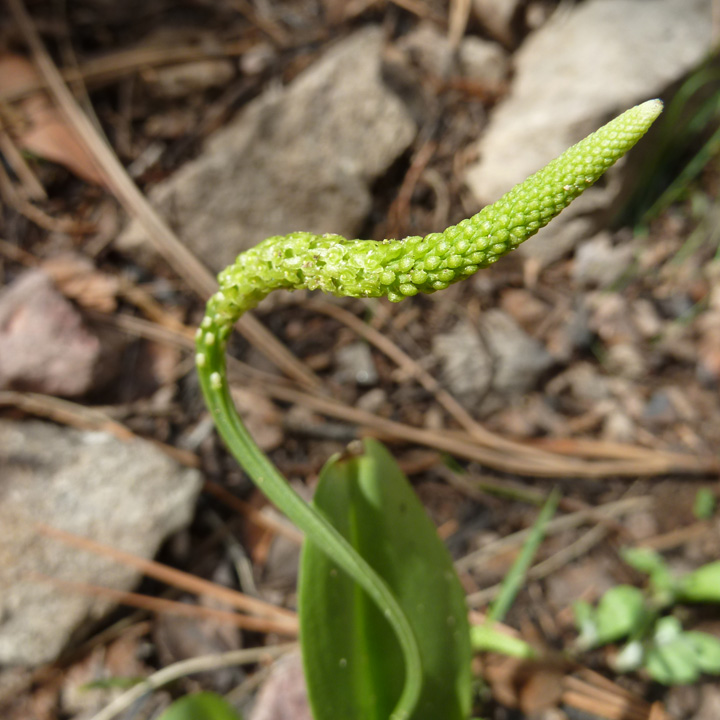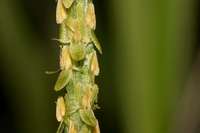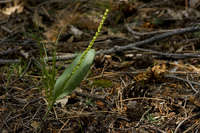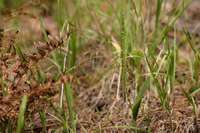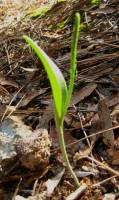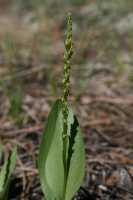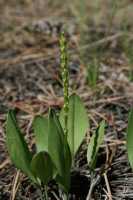
|
|
|
|
Family: Orchidaceae
Chiricahua Adder's-Mouth Orchid, more...Chiricahua addersmouth orchid
[Malaxis macrostachya (Lex.) Kuntze] |
Plants 11-60 cm. Pseudobulbs 5-15 mm diam. Leaves 1, at middle or proximal 1/3 of stem, sheathing leaf bases persistent, shredding; blade ovate-elliptic or oblanceolate, keeled abaxially, 2.4-15 × 1-5.2(-6) cm, apex acute. Inflorescences spicate racemes, rachis thick, slightly ridged or fluted, 6-22 cm; floral bracts triangular to lanceolate, 0.5-1 mm; pedicels 1.3-1.7 mm. Flowers 40-160, not resupinate, green to yellowish green; dorsal sepal ovate to elliptic, 1.5-2.8 × 0.8-1.3 mm, apex acuminate; lateral sepals ovate to elliptic, falcate, 1.5-2.8 × 0.8-1.3 mm, apex acuminate; petals strongly reflexed, filiform to linear, falcate, 1.3-2 × 0.2-0.3 mm, apex acuminate; lip suborbiculate-ovate to subquadrangular-ovate, 1.5-2.8 × 1.3-2.2(-2.5) mm, base hastate-auriculate, apex obliquely 3-dentate or retuse with apiculum in sinus; disc deeply concave, 5-veined; column 0.2-0.5 × 0.2-0.5 mm; pollinia yellow. Capsules ascending, ellipsoid, 7 × 3 mm. Flowering Jul--Sep. Moist, wooded canyons and ravines, rocky open slopes, pine savannas; 2000--3000 m; Ariz., N.Mex., Tex.; Mexico; Central America. Malaxis soulei grows in the Santa Catalina, Santa Rita, and Chiricahua mountains in Arizona, and in the Davis Mountains in Texas. The flowers of Malaxis soulei are retained on the axis until the capsules are fully developed, unlike M. corymbosa and some other species where the flowers fall quickly if not fertilized. The apparently sessile flowers are a very distinctive characteristic of this species. The central apiculum of the lip may be obsolete, and the apex thus retuse. The name Malaxis macrostachya has been applied to M. soulei (C. A. Luer 1975). It is a nomen confusum, however, and it is not clearly applicable to this species (L. O. Williams 1965).
Martin and Hutchins 1980, FNA 2002, Coleman 2002 Duration: Perennial Nativity: Native Lifeform: Forb/Herb General: Scapose stems swollen from stem, arising from pseudobulb usually 5-10 cm below the soil surface to 35 cm tall Leaves: Usually 1, lanceolate to ovate to ovate-elliptic, sometimes slightly cordate at the base, with scalelike bracts toward the base of the scape, 2.5-15 cm long by 1.5-2 cm wide, the sheathing leaf bases are persistent and shedding. Flowers: Usually 40-160, not resupinate and arranged on a terminal raceme or spike that is narrow and elongate, the flowers sessile and dense, the perianth yellowish green with spreading sepals, the perianth 3-4 mm long, the segments oblong to oblong-lanceolate or ovate. Fruits: Minute capsule ascending, ellipsoid, 7 by 3 mm. Ecology: Found in mixed or pure stands of oak, juniper, pine and fir from 5,500-10,000 ft (1676-3048 m), flowers July-September. Distribution: Grows in ponderosa-oak, ponderosa, and mixed conifer forests and woodlands throughout Arizona, into northern New Mexico and east to Texas. It ranges south throughout Mexico to Central America. Notes: A generally inconspicuous orchid that grows with the monsoon rains, with even the flowers being difficult to see without magnification. Distinctive because of its large green leaf growing sheathed around the single spike of many minute greenish white flowers. There remains an element of confusion about whether M. macrostachya is conflated with this species, FNA indicates this was a misapplication of the nomenclature in a 1975 paper. Further phylogenetic research is going to be necessary to determine this species- precise nomemclature and overall distribution. The type specimen was collected on Mt. Graham in 1874 by J.T. Rothrock. Ethnobotany: Unknown Etymology: Malaxis is from the Greek word for soft or softening, a reference to the tender leaves, while soulei is named for Justus F. Soule, a professor at the University of Wyoming. Synonyms: Many, see Tropicos Editor: SBuckley 2011 |
This project was made possible in part by the Institute of Museum and Library Services [MG-70-19-0057-19].
Powered by Symbiota

